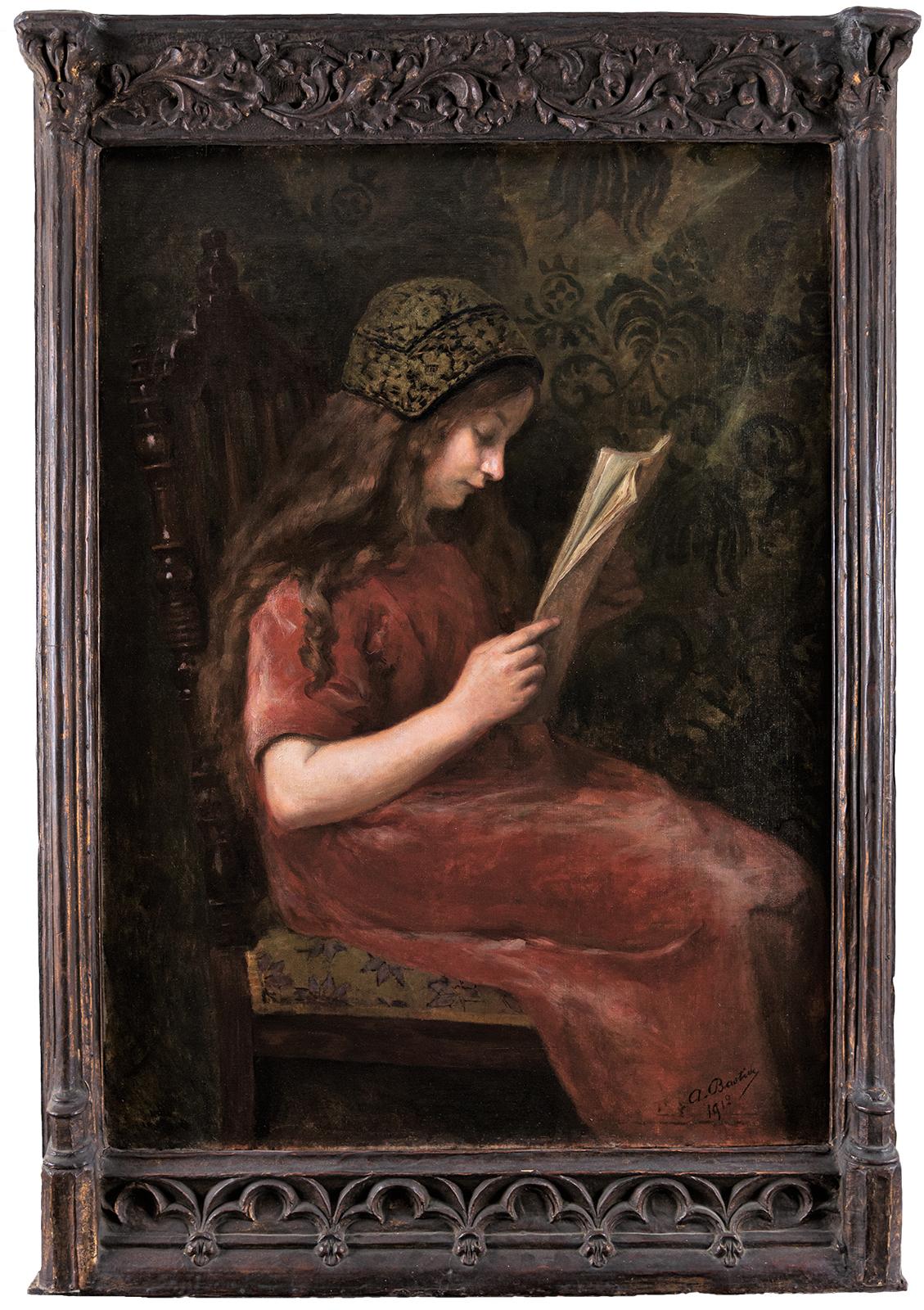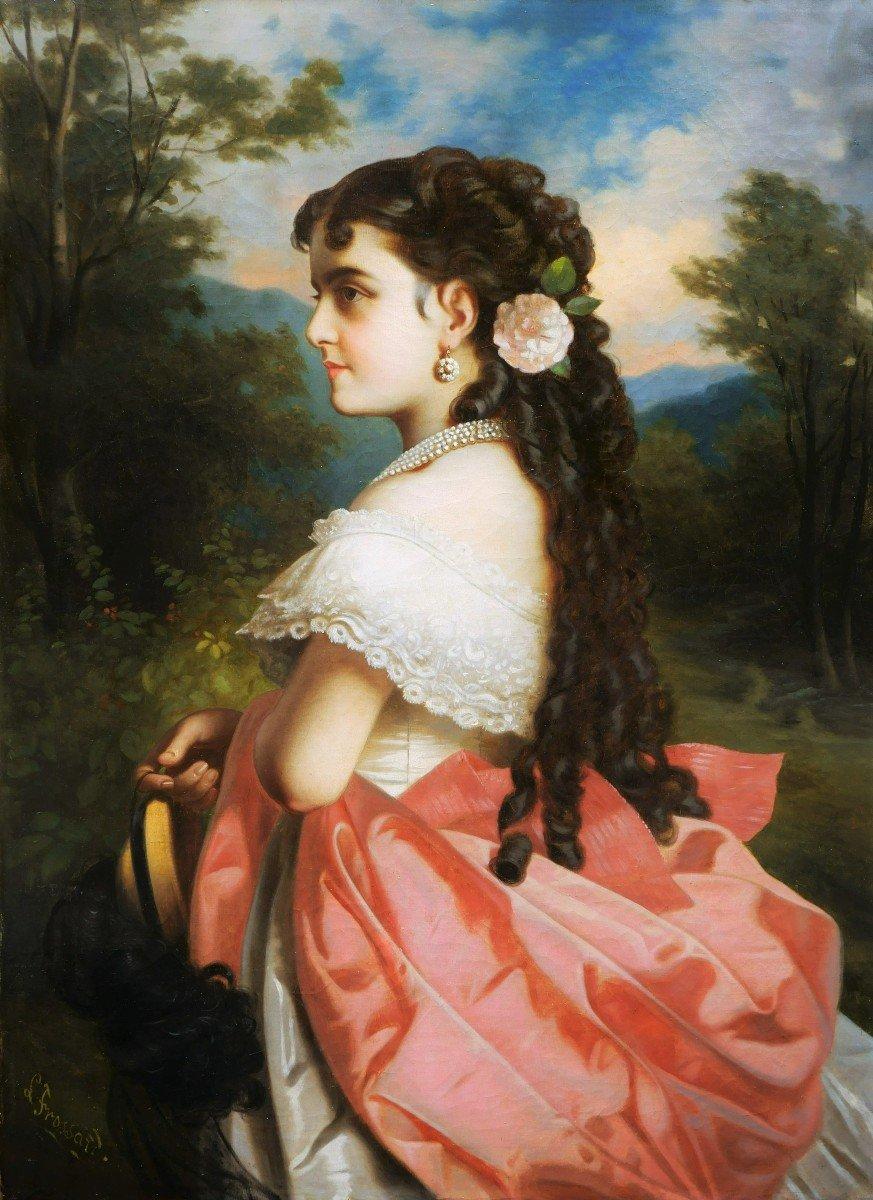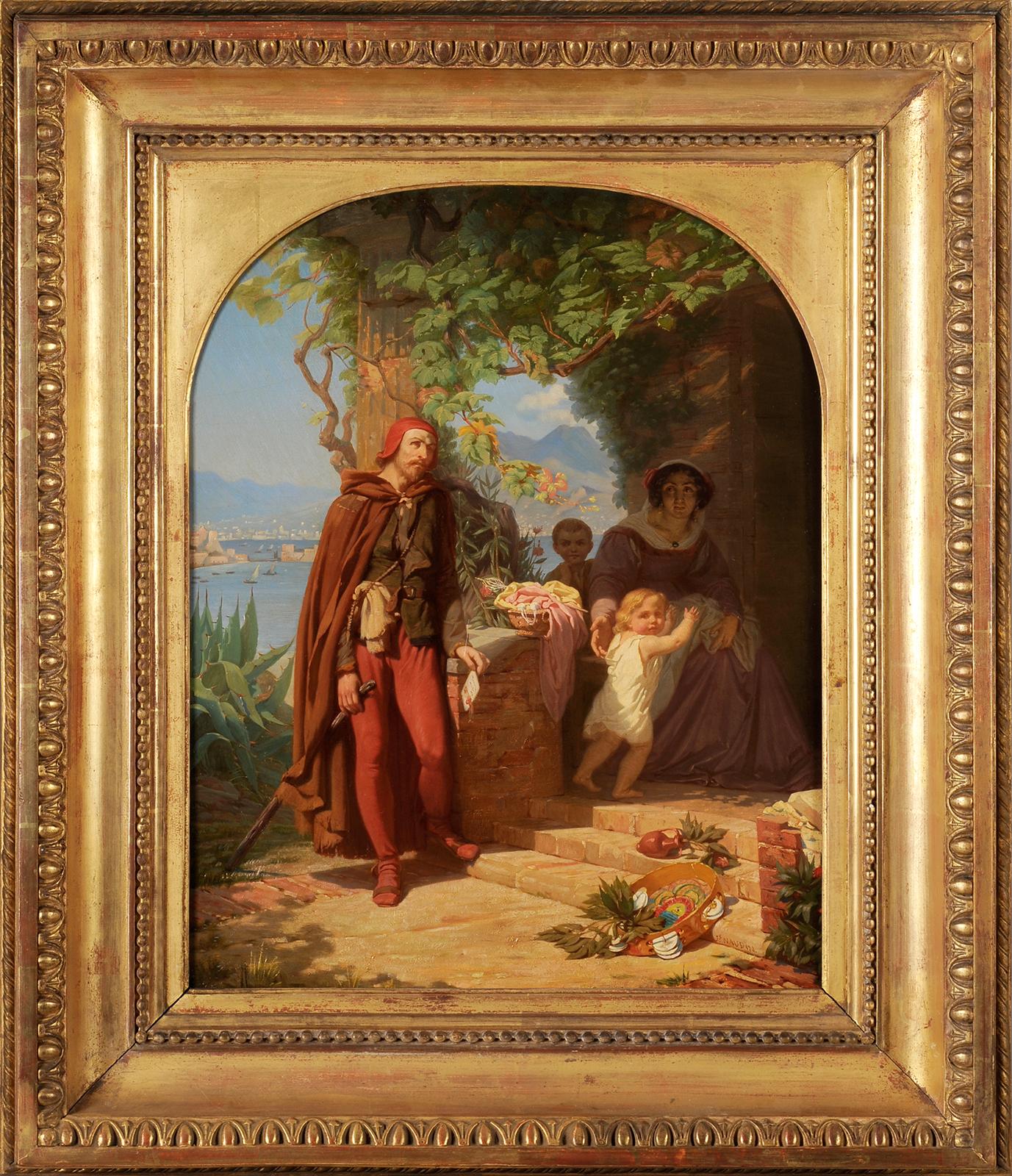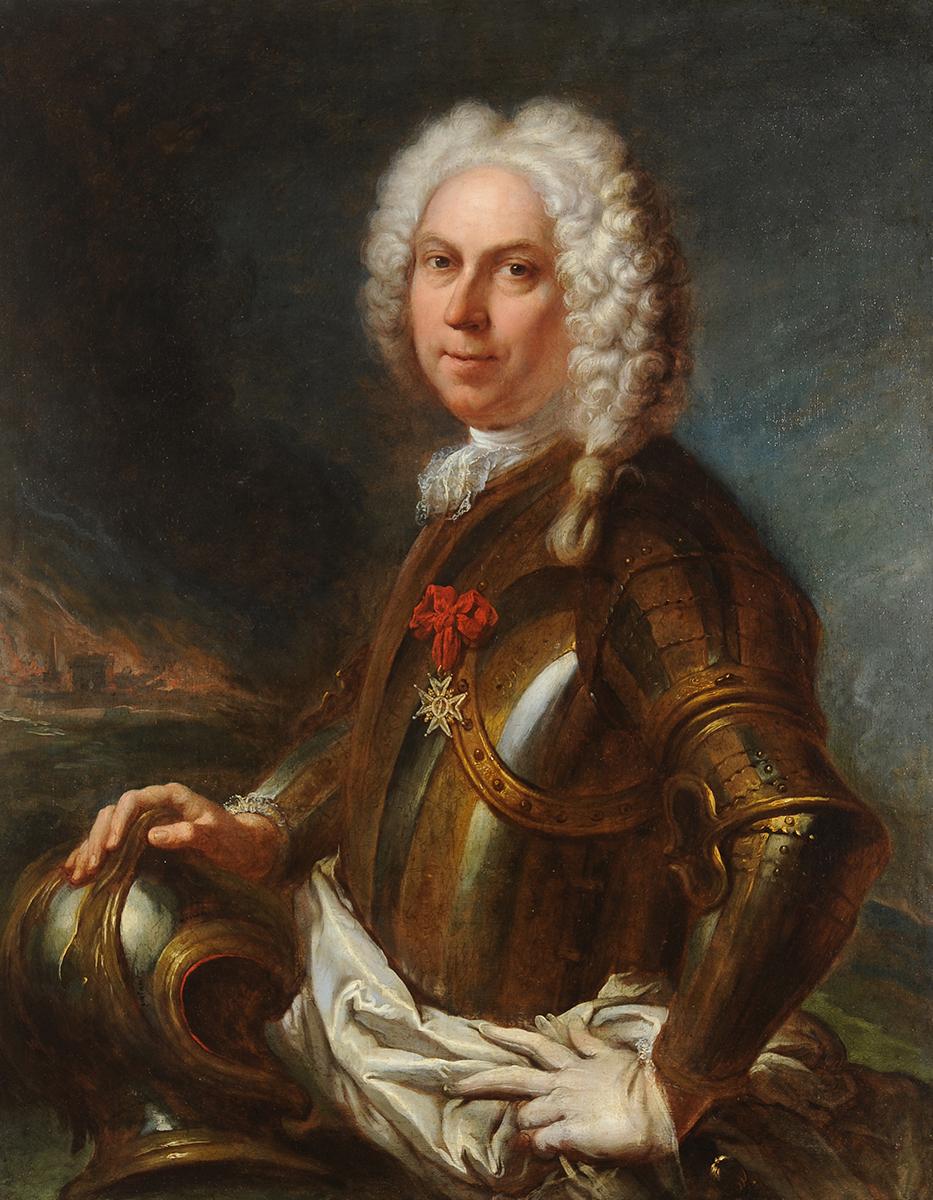Items Similar to Portrait of a Lady Holding a Fan - French 19thC oil painting indistinctly signed
Want more images or videos?
Request additional images or videos from the seller
1 of 17
UnknownPortrait of a Lady Holding a Fan - French 19thC oil painting indistinctly signed1879
1879
About the Item
This charming 19th century portrait oil painting is attributed to the French School and painted by a female artoist. It has the composition and delicacy of French academic painters such as Ingres and Jerome. It was painted in 1879 in Paris. It is a half-length portrait of a young woman wearing a bonnet and blue dress with long gloves and holding a fan. Her dark hair is curling down her back and she is gazing to her left. It is a beautiful vibrant painting with lovely details and brushwork.
Indistinctly signed upper left, dated 1879 and states Paris.
Provenance: Hampshire estate.
Condition. Oil on canvas, 28 inches by 22 inches, in good condition.
Frame. Housed in gilt frame, in good condition, 33 inches by 27 inches approx.
- Creation Year:1879
- Dimensions:Height: 33 in (83.82 cm)Width: 27 in (68.58 cm)Depth: 2 in (5.08 cm)
- Medium:
- Movement & Style:
- Period:
- Condition:
- Gallery Location:London, GB
- Reference Number:1stDibs: LU853113539442
About the Seller
5.0
Platinum Seller
These expertly vetted sellers are 1stDibs' most experienced sellers and are rated highest by our customers.
1stDibs seller since 2018
398 sales on 1stDibs
Typical response time: <1 hour
- ShippingRetrieving quote...Ships From: London, United Kingdom
- Return PolicyA return for this item may be initiated within 14 days of delivery.
More From This SellerView All
- Portrait of a Boy with Bird - British 17th century art Old Master oil paintingLocated in London, GBThis stunning 17th century Old Master portrait oil painting is attributed to Godfrey Kneller. Painted circa 1680 it is a superb full length portrait of a blonde haired boy holding a struggling bird. He is bare foot and dressed in a white shirt with gold shawl around him. In the background is a blue drape. There is lovely detail and brushwork in his facial features and vibrant colouring. This a superb 17th century Old Master oil painting housed in a lovely frame. Provenance. Two ascribed labels verso Christie's stamp verso. . Condition. Oil on canvas in good condition, 36 inches by 28 inches approx. Frame. Housed in an ornate frame, 43 inches by 35 inches approx. Sir Godfrey Kneller, 1st Baronet (born Gottfried Kniller; 8 August 1646 – 19 October 1723), was the leading portrait painter in England during the late 17th and early 18th centuries, and was court painter to English and British monarchs from Charles II to George I. Kneller was born Gottfried Kniller in the Free City of Lübeck, the son of Zacharias Kniller, a portrait painter. Kneller studied in Leiden, but became a pupil of Ferdinand Bol and Rembrandt Harmenszoon van Rijn in Amsterdam. He then travelled with his brother John Zacharias Kneller, who was an ornamental painter, to Rome and Venice in the early 1670s, painting historical subjects and portraits in the studio of Carlo Maratti, and later moved to Hamburg. The brothers came to England in 1676, and won the patronage of the Duke of Monmouth. He was introduced to, and painted a portrait of, Charles II. In England, Kneller concentrated almost entirely on portraiture. In the spirit of enterprise, he founded a studio which churned out portraits on an almost industrial scale, relying on a brief sketch of the face with details added to a formulaic model, aided by the fashion for gentlemen to wear full wigs. His portraits set a pattern that was followed until William Hogarth and Joshua Reynolds. Nevertheless, he established himself as a leading portrait artist in England. When Sir Peter Lely died in 1680, Kneller was appointed Principal Painter in Ordinary to the Crown by Charles II. For about 20 years (c.1682-1702) he lived at No. 16-17 The Great Piazza, Covent Garden. In the 1690s, Kneller painted the Hampton Court Beauties depicting the most glamorous ladies-in-waiting of the Royal Court for which he received his knighthood from William III. He produced a series of "Kit-cat" portraits of 48 leading politicians and men of letters, members of the Kit-Cat Club. Created a baronet by King George I on 24 May 1715, he was also head of the Kneller Academy of Painting and Drawing 1711–1716 in Great Queen Street, London, which counted such artists as Thomas Gibson amongst its founding directors. His paintings were praised by Whig members including John Dryden, Joseph Addison, Richard Steele, and Alexander Pope. On the landing in Horsham Museum hang works of art from the Museum's extensive painting collection, featuring a large 18th-century portrait of Charles Eversfield and his wife, of Denne Park House. In the painting Eversfield is giving his wife some violets which signifies fidelity, love and honesty. It is likely that the picture was cut down at some time as it was unusual to stop just below the knee. It may have been painted by more than one person: someone who specialised in clothing, another in drapes, and so on, with perhaps Kneller painting the heads, for it was the portraits that gave the sitters their identity, everything else is rather formulaic. He married a widow, Susanna Grave, on 23 January 1704 at St Bride...Category
1680s Old Masters Portrait Paintings
MaterialsOil
- Race Horse Phoenix with Guilermo Kemmis - British 19th century art oil paintingLocated in London, GBThis superb British 19th century equine oil painting is by noted horse lover, George Gascoyne. Painted in 1889, this French born chestnut horse is Phoenix. While he was essentially a...Category
1880s Realist Animal Paintings
MaterialsOil
- Exotic - Scottish 1920's exhibited 'Glasgow Girl' art portrait oil paintingLocated in London, GBThis stunning much exhibited 1920's Scottish portrait oil painting is by noted Glasgow Girl artist Norah Nielson Gray. Painted circa 1923, the model for the painting was Rita McIlraith but the artist did not want to use her name in the title and it was called 'Exotic.' Norah Neilson Gray...Category
1920s Art Deco Portrait Paintings
MaterialsOil
- Man Reading Newspaper - Orientalist art 19th century portrait oil paintingLocated in London, GBThis striking large Orientalist oil portrait painting is by a talented Turkish School artist from the late 19th century. The portrait is extremely well painted, dating to circa 1890 ...Category
19th Century Realist Portrait Paintings
MaterialsOil
- Art Deco Portrait of a Lady - British 1920's art female portrait oil paintingBy Leon SprinckLocated in London, GBThis lovely Art Deco portrait oil painting is by noted British prolific society portrait artist Leon Sprinck. Painted in 1924 it is a half length portrait of a beautiful blonde woman, stood smiling at the artist/viewer, her head tilted to one side. We don't know the sitter's name or her relationship to the artist but her pose suggests a degree of familiarity and warmth between them. She is wearing a sleeveless black dress with beautiful Art Deco motifs, a long string of pearls...Category
1920s Art Deco Portrait Paintings
MaterialsOil
- The Gossip - Scottish 19thC art Victorian oil painting young romantic coupleBy William Fettes DouglasLocated in London, GBA fine Victorian Scottish genre oil on canvas painting which dates to 1868 and is titled The Gossip by famous Scottish artist William Fettes Douglas RSA. It is a stunning depiction o...Category
19th Century Victorian Figurative Paintings
MaterialsOil
You May Also Like
- Woman with Lobsters / "Femme et Homards"By Andre MinauxLocated in Berlin, MDAndre Minaux (French 1923 - 1986) "Femme et Homards" / Woman with Lobsters. Oil on canvas. Features a young woman holding one lobster while two others sit on a counter before her. ...Category
Mid-20th Century French School Portrait Paintings
MaterialsCotton Canvas, Oil
- Portrait of singer Adelina Patti - L. Frossard - OperaLocated in BELEYMAS, FRL. FROSSARD (active in Vienna around 1870) Portrait of Adelina Patti (1843-1919) Oil on canvas H. 100.5 cm; L. 73.5 c Signed lower left If the artist maintains a certain discretion ...Category
1860s French School Figurative Paintings
MaterialsCanvas, Oil
- Jules Naudin (1817-c.1876) - Tasso arriving at his sister's house in SorrentoBy Attilio ManganaroLocated in BELEYMAS, FRJules Ambroise Francois NAUDIN (Paris 1817 – c.1876) Tasso arriving at his sister's house in Sorrento Oil on canvas H. 49 cm; L. 37.5 cm Signed lower right Exhibition: 1852, Paris Salon, under number 959 Related work: Engraving by Jean-Denis Nargeot in 1852 Bibliography: L’Illustration, April 24, 1852, engraved by Best, Hottelin and Regnier, after a drawing by Valentin) and reproduced p.260, cited p.262; La Mode: Political, Religious and Literary Review, 1852, quoted; Journal des Demoiselles...Category
1850s French School Figurative Paintings
MaterialsCanvas, Oil
- Model undressingLocated in BELEYMAS, FRJulius EXNER (Copenhagen, 1825 - Copenhagen, 1910) Model stripping Oil on canvas H. 122 cm; L. 74 cm Signed and dated 1842 lower right Exhibition: most likely Charlottenborg Salon of 1845, under number 110, titled Modelfigur, awarded with a silver medal Provenance: Emilio Fernando Bolt (c.1860 - 1944), acquired from the artist around 1900, then by descent Our painting was produced as part of the summer sessions organized between 1839 and 1850 by Christoffer Wilhelm Eckersberg (1783-1853), the master of Danish painting of the first half of the 19th century, in his private studio-apartment on the ground floor. floor at the Royal Academy of Fine Arts in Copenhagen. The master brought together a few students there between June and September, rented one or two models for the season, which were painted from different angles, the artists (including Eckersberg himself) sitting side by side. Eckersberg used to paint a fairly small version, the pupils of the larger formats. The work fits more generally into the legendary context of the research and reforms carried out by Eckersberg concerning the studies of nudes and in particular of female nudes, to make this exercise a genre of painting in its own right. Following his two-year stint in Jacques-Louis David's studio in Paris in 1811, Eckersberg had been made aware of work on the nude and in particular on live models, in natural light, while in Denmark the drawings were then only made from casts of antique models or other mannequins. In 1822, when he had been a professor there since 1818, it was he who had the Royal Academy of Copenhagen authorize the study of nudes, no longer in the evening by candlelight, but in natural light; from 1833, it was still he who allowed students to work on nude female models, even if the official authorization of the Academy did not take place until 1839. It was this same year that he instituted his summer sessions, on a private basis, to orient his painting and that of his students towards a new conception of the representation of models: even if the nude remains the real theme, it does not however, this is more than just an academic exercise. The subject is placed in a contemporary interior, with a rather sophisticated decor, and occupied with an intimate activity (it is this type of intimate vein that we will find later in Degas or Cassatt for example); thus in our painting, the young woman is supposed to take off her clothes to wash. The objective is that the viewer forgets that the master and his students are painting a model during a posing session, and that he instead has the impression of being alone with the model, but invisible, almost like a voyeur in spite of himself. Moreover, in these paintings, the model never looks towards the spectator, inducing a psychological distance with him, whereas model and artist are actually physically very close. On the other hand, it is not a question of idealized nudes either, even if Eckersberg, proof of his debt to the antique, chooses fairly classic models and poses. The sensuality is real and very present, with dreamy, even innocent, and timeless expressions (the models do not seem to have a defined age), suave and slow attitudes and movements, and especially with clothes that hide or reveal skillfully parts of the female body: upper buttocks, pronounced hips... Made by an artist under 20, our sensual painting is probably one of the most beautiful and spectacular produced by the students of Eckersberg during these summer sessions. With a perfect balance between the firmness of an ancient statue (it recalls the Venus de Milo) and the softness of the feminine forms, highlighted by a harmonious palette, it captures the attention with many details: the almost photographic folds white clothing...Category
1840s French School Nude Paintings
MaterialsCanvas, Oil
- Portrait of a man in armorLocated in BELEYMAS, FRAttributed to Jacques DUMONT aka DUMONT LE ROMAIN (Paris 1701 - 1781) Presumed portrait of Louis-Joseph de Formanoir (?-1732) Oil on canvas H. 91.5 cm; ...Category
1750s French School Figurative Paintings
MaterialsCanvas, Oil
- Young girl readingLocated in BELEYMAS, FRAlice BASTIDE (Saint Mandé 1868 – Paris 1959) Portrait of a little girl reading Oil on canvas H. 100 cm; L. 72.5 cm Signed lower right and dated 1912 Daughter of a pastor from Gard and an English woman, Alice Bastide grew up in Paris. A pupil of the Jullian Academy, she began her apprenticeship under the guidance of Henri Royer and François Schommer. The development of his art is mainly oriented towards still lifes, without completely abandoning portraits and landscapes. Her other specialty for which she received numerous awards is miniatures. At the Salon of 1914 she received the Maxime David prize crowning the best piece while her finesse was already noticed by press critics from 1907. Coronation, in 1926 she received a gold medal at the Salon for her miniature Coquetterie. In 1896, the young woman married a man from Gard, Auguste Massebiaux, whose name she would occasionally bear. The latter, a lawyer at the Paris Court of Appeal, died in 1910. The couple had no children. At that time she was domiciled at 48 avenue d'Orléans (later named avenue du general Leclerc) in Paris where she lived until her death in 1959. Until the mid-1930s she continued to exhibit at the Salon des Artistes French with a manner very close to Impressionism, luminous and vigorous. In 1912, two years after the death of her husband, Alice Bastide was certainly still marked by the sadness of her mourning. The tones of our portrait of a little girl and the frame she puts together are dark and heavy. This child, wearing an embroidered bonnet, is bent over her book, her loose hair flowing over a red velvet indoor dress. This intimate portrait on a dark tapestry...Category
1910s French School Figurative Paintings
MaterialsOil, Canvas





